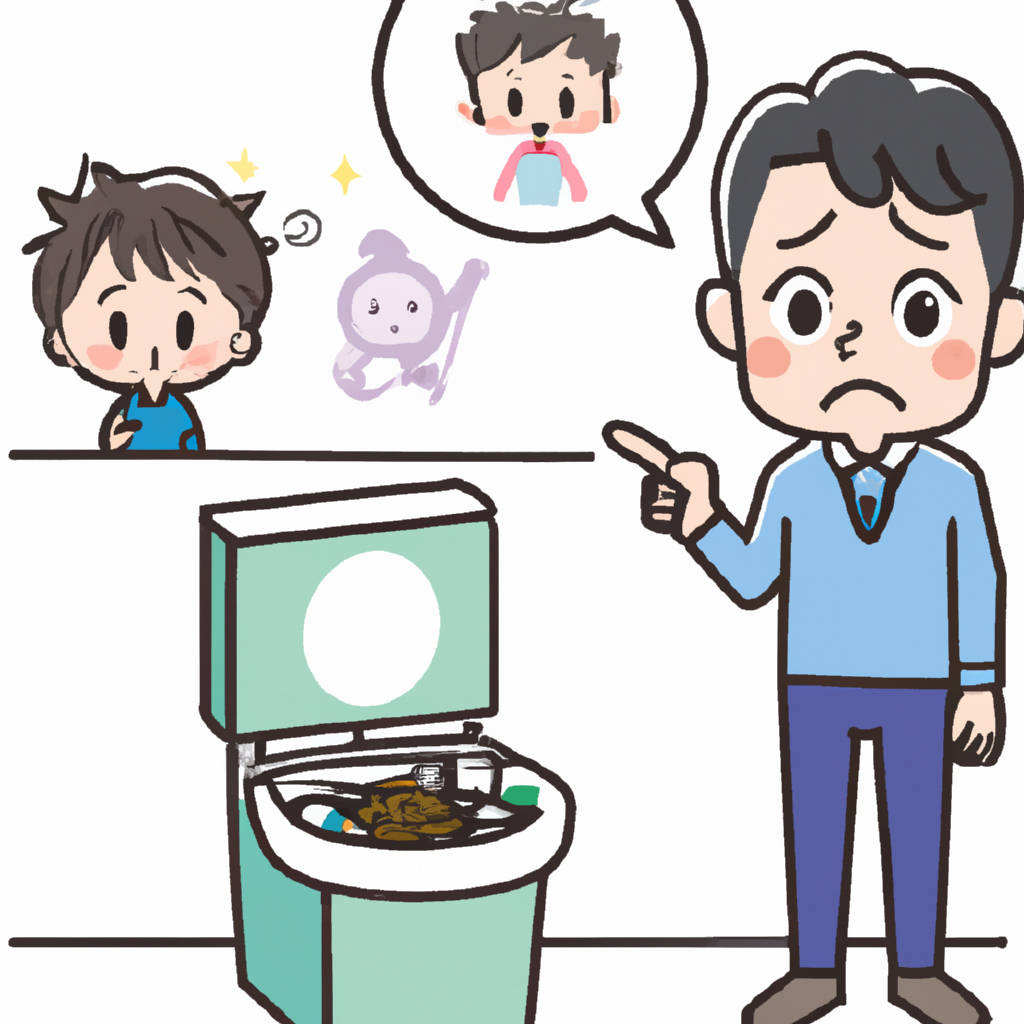Managing fecal soiling, also known as encopresis, in children, involves addressing both the physical and emotional aspects of the problem. Typically occurring in children aged four and older, this condition is often linked to chronic constipation where the child’s rectum becomes so full of hard, compacted stool that fresh stool from higher up in the body ‘leaks’ around it and out of the body, causing soiling. The first step in managing this issue is through a medical evaluation to identify any underlying physical causes, which might include diet, fluid intake or lack of physical activity. If constipation is identified as a contributing factor, then treatment may involve medication to clear the bowel, followed by a maintenance program that includes dietary changes, regular toilet routines, and possibly the continued use of medication.
However, it’s also crucial to acknowledge the emotional and psychological aspects of fecal soiling. Children may experience embarrassment, shame, or frustration, which can lead to behavior problems and difficulties in social or school environments. In these instances, psychological interventions such as cognitive behavioral therapy (CBT) can be beneficial. CBT can help children understand and manage their feelings related to encopresis, develop coping strategies, and improve self-esteem.
Parents and caregivers play a vital role in managing fecal soiling. It’s essential for them to approach the issue with empathy, patience, and understanding. Avoiding punishment and instead using positive reinforcement can significantly assist in improving the child’s bowel habits. Additionally, parents should work closely with healthcare professionals to ensure they are providing the necessary support and following the prescribed management plan.
Education is another fundamental aspect of managing fecal soiling. Children should be taught about the normal process of bowel movements and the importance of not ignoring the urge to go to the toilet. Simple explanations about how the body works can help to alleviate fear or confusion and can empower the child to take control of their own body.
Overall, managing fecal soiling in children requires a comprehensive approach that addresses the physical causes, provides emotional support, utilizes appropriate therapeutic strategies, and involves active participation from both the child and their caregivers. Understanding and patience are key in helping the child overcome this challenging issue and improve their quality of life.

Understanding the Issue
Understanding the issue refers to the process of comprehending the core aspects, implications, and potential solutions of a problem or situation. It involves delving into the root causes and primary factors that have contributed to the emergence of the issue. This process is critical in any decision-making or problem-solving scenario as it helps in developing a deeper comprehension of the situation at hand. Understanding the issue goes beyond simply identifying the problem. It requires analytical thinking, empathy, and a broad perspective.
A significant part of understanding the issue involves examining the various perspectives involved. Often, issues are complex and multifaceted with numerous stakeholders, each with their unique viewpoints and interests. Acknowledging these various perspectives is crucial to get a holistic understanding of the issue. Moreover, it also involves understanding the historical context or previous events that may have led to the current situation.
Furthermore, it is important to consider the potential implications and consequences of the issue. What could be the short-term and long-term effects if the issue remains unresolved? Who will be affected, and how? Answering these questions can provide valuable insights into the seriousness and urgency of resolving the issue.
Finally, understanding the issue is not complete without contemplating possible solutions or ways to address the issue. This involves brainstorming, research, and sometimes, experimentation. It requires creativity, logic, and sometimes, a willingness to take calculated risks.
In summary, understanding the issue is an essential step in problem-solving and decision-making. It involves a thorough investigation of the problem, its causes, its implications, and ways to resolve it. It requires an open mind, empathy, and the ability to see the issue from multiple perspectives. Without a proper understanding of the issue, any attempts at resolution may be ineffective or even counterproductive.
Addressing Constipation
Addressing constipation often involves making lifestyle changes that foster better digestive health. Often, inadequate intake of dietary fiber, insufficient hydration, and lack of physical activity can lead to this uncomfortable condition. Increasing the intake of fiber-rich foods like fruits, vegetables, and whole grains can help stimulate bowel movements. Hydration is also crucial, as water helps soften stool, making it easier to pass. Regular exercise can stimulate the muscles in the lower part of your body, which can help bowel movements occur more regularly. Moreover, it’s essential to heed nature’s call and not delay bowel movements as this can lead to constipation. In some cases, over-the-counter laxatives might be necessary, but they should be used sparingly, as overuse can cause the body to become dependent on them for normal bowel function. If these adjustments don’t alleviate constipation, it may be a sign of a more serious underlying condition, such as irritable bowel syndrome or a thyroid issue, and medical attention should be sought. Addressing constipation effectively requires an understanding of its causes, a commitment to lifestyle changes, and in some cases, medical intervention.

Establishing a Routine
Establishing a routine is a critical element of achieving balance and productivity in one’s life. Routines provide structure and a sense of order, aiding in time management and facilitating efficiency. Having a routine can help reduce stress levels, as it eliminates the need to constantly plan and think about what comes next. This, in turn, allows for a more focused mindset and enables one to dedicate their energy fully to the task at hand.
Implementing a routine involves identifying daily tasks and organizing them in a manner that best suits one’s lifestyle and personal preferences. This could involve setting aside specific times for meals, work, exercise, relaxation, and sleep. A routine doesn’t have to be rigid; it can be flexible and adaptable to accommodate unexpected situations or changes in one’s mood or energy levels.
The key to establishing a successful routine is consistency. It is important to stick to the routine as closely as possible, even on days when motivation may be low. This cultivates discipline and helps form habits, making it easier to maintain the routine over time. However, it’s also crucial to allow room for spontaneity and leisure, to prevent the routine from becoming monotonous or overwhelming.
While the benefits of having a routine are numerous, it’s equally essential to ensure that the routine is sustainable. It should be realistic and achievable, taking into account one’s commitments, capabilities, and personal inclinations. Overburdening oneself with an overly demanding routine can lead to burnout and defeat the purpose of having a routine in the first place.
In conclusion, establishing a routine is an effective strategy for managing one’s time and tasks, reducing stress, and enhancing productivity. It’s a process that requires planning, consistency, and balance, with the ultimate aim of creating a more structured and efficient daily life.
Encouraging Positive Reinforcement
Encouraging positive reinforcement is a crucial aspect of molding behavior, particularly in education and parenting. It’s a technique that involves the use of praise or rewards to inspire and motivate individuals to maintain desirable behavior or attitudes. This concept is anchored on the belief that responses to certain actions, if positive, could stimulate a repetition of the same actions. For instance, when a child tidies up their room and is praised or rewarded for it, they are more likely to repeat the action in the future. Hence, the positive reinforcement not only enhances self-esteem but also promotes self-efficacy.
Following this approach, educators and parents can help shape the behavior and attitudes of children in a way that fosters a positive growth environment. It helps in building a stronger and healthier relationship between the individual providing the reinforcement and the one receiving it. It also reduces the chance of negative behaviors emerging, as the focus is shifted towards recognizing and rewarding positive actions.
Moreover, this method is not limited to younger individuals; it can also be applied in workplaces to boost productivity and morale. Managers can use positive reinforcement to acknowledge employees’ efforts, thus encouraging them to maintain or even exceed their current performance. The rewards can take various forms, from verbal acknowledgment to material incentives.
It’s essential to note that the timing and consistency of positive reinforcement are crucial in making it effective. The response should immediately follow the desired behavior, and the reinforcement should be consistent to make the behavior habitual.
In conclusion, encouraging positive reinforcement is an effective tool in shaping behavior and attitudes, promoting a healthier and more positive environment whether it be at home, in school, or at the workplace.

Medical Evaluation
Medical evaluation is an essential part of health care, used to determine an individual’s overall physical health and detect any underlying ailments. This comprehensive assessment includes a series of tests and examinations that provide a holistic view of the patient’s health status. A medical evaluation typically includes a detailed medical history review, a physical examination, and diagnostic tests as needed. The medical history review involves a thorough discussion about a patient’s past illnesses, surgeries, allergies, and family history of diseases. This helps the medical professionals to understand the patient’s health background and any potential risk factors.
The physical examination includes checking vital signs such as blood pressure, heart rate, and respiratory rate. It also involves the examination of different body systems such as respiratory, cardiovascular, nervous, gastrointestinal, musculoskeletal, and urogenital systems. This helps to identify any abnormalities or dysfunctions in these systems.
Diagnostic tests such as blood tests, imaging studies, and other laboratory tests may be performed based on the findings of the history and physical examination. These tests can further confirm or rule out the presence of certain diseases or conditions.
The results of a medical evaluation are crucial in guiding the course of treatment, as they provide a comprehensive understanding of the patient’s health status. The data collected from the evaluation can then be used to develop a personalized treatment plan that addresses the patient’s unique needs and concerns. The overall goal of a medical evaluation is to promote optimal health and well-being, prevent illnesses, and manage existing conditions effectively.
It is important to have regular medical evaluations as they can help detect health problems at an early stage when they are easier to treat. They also provide an opportunity for individuals to discuss any health concerns or questions they may have with their healthcare provider.
In conclusion, medical evaluations are a vital tool in modern healthcare, facilitating the prevention, detection, and management of various health conditions.
Behavioral Approaches
Behavioral approaches are critical in shaping human behavior and are widely used in various fields such as psychology, medicine, education, and business. These approaches focus on understanding the causes of behavior and finding effective ways to change or manage it. Behavioral approaches are often based on principles of operant conditioning, a psychological theory that suggests behavior can be modified through rewards or punishments.
These strategies can be applied in diverse contexts to address a wide range of issues. In education, for instance, behavioral approaches may be used to promote positive behaviors among students, such as attentiveness, respectfulness, and responsibility. Here, reinforcing desirable behaviors with praise or rewards can encourage their repetition. On the other hand, undesirable behaviors can be discouraged through consequences such as loss of privileges.
In the medical field, behavioral approaches can be crucial in managing conditions like addiction, obesity, and mental health disorders. For example, cognitive-behavioral therapy, a type of behavioral approach, is widely used in the treatment of anxiety and depression. This therapy helps patients understand their thoughts and feelings, and how these may influence their behavior, thereby providing them with strategies to manage their symptoms.
In the business world, behavioral approaches can play a pivotal role in managing and motivating employees. By understanding what drives their behavior, organizations can devise strategies to encourage productivity, creativity, and job satisfaction. For example, employees may be motivated to increase their performance if they know they will receive a bonus or promotion.
Overall, behavioral approaches offer a powerful tool for understanding and influencing human behavior in various contexts. They are grounded in empirical evidence, making them reliable and effective. However, it’s important to consider individual differences and cultural factors when applying these strategies, as what works for one person may not work for another.

Hygiene and Comfort
Hygiene and comfort are two essential aspects of a well-rounded lifestyle. Maintaining cleanliness, both personally and in your surroundings, is not only vital for health but it also contributes to a sense of comfort. A clean environment is usually linked to a calmer, more relaxed state of mind. There’s something soothing about residing in a tidy, uncluttered space, or wearing clean, fresh clothes. It’s a feeling of control and order, a reprieve from the chaos of the world outside.
Similarly, personal hygiene has a significant impact on a person’s overall comfort and wellness. Regular bathing, brushing teeth, and washing hands can reduce the risk of illnesses and infections. But more than just physical health, personal hygiene can also influence a person’s psychological and social well-being. It can boost self-esteem, improve interpersonal relationships, and enhance mental health.
Moreover, hygiene and comfort intertwine in the context of personal care products.
Many people find solace in routines that involve grooming and self-care. These routines can be therapeutic, providing a sense of calm and relaxation. Whether it’s a bubble bath with a favorite scented soap, applying a nourishing hand cream, or using a refreshing face wash, these rituals often provide a sense of comfort and tranquility. The very act of taking care of oneself can be a form of self-love, promoting a positive self-image and a healthy mindset.
In conclusion, hygiene and comfort are closely interlinked and fundamental to a person’s well-being. A clean environment and personal cleanliness not only promote a healthier lifestyle but also foster a sense of peace, order, and control. By engaging in self-care routines, individuals are able to nurture both their physical health and mental well-being, creating a more balanced, comfortable life.
Support and Patience
Support and patience are two essential virtues that foster growth and success in various spheres of life. They act as the cornerstone in relationships, work environments, or any setting that requires human interaction. Offering support to others is a selfless act that demonstrates empathy and understanding, which can significantly uplift the spirit of the recipient. It could be as simple as lending an ear to listen, a shoulder to lean on, or offering help based on the situation. On the other hand, patience is the ability to endure difficult circumstances, delays, or frustrations without becoming agitated or upset. It involves having a tolerant and forgiving attitude towards others, which can help build stronger relationships and foster a peaceful environment.
The combination of support and patience is a powerful tool in overcoming challenges and navigating through life’s hardships. It is through patience that we learn to cope with life’s adversities, and it is through support that we find the strength to keep going. In the world of parenting, education, or therapy, the blend of these two virtues is crucial in helping individuals grow and develop. The role of support and patience in leadership cannot be overlooked as well. Leaders who exercise patience and provide support to their team members foster a positive work environment, which consequently leads to higher productivity. In a world that’s often too hurried, the value of support and patience cannot be understated. They are the glue that holds society together, promoting unity, cooperation, and understanding among individuals. Being supportive and patient not only benefits those around us, but it also enriches our own lives, making us more compassionate, tolerant, and resilient.